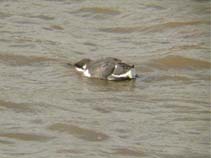Alca torda Linnaeus, 1758
Razorbill
Classification / Names Common names | Synonyms | CoL | ITIS | WoRMS
| Charadriiformes | Alcidae
Environment: milieu / climate zone / depth range / distribution range Ecologia
; intervalo de profundidade 0 - 120 m (Ref. 62202). Polar; 82°N - 27°N, 80°W - 43°E (Ref. 124582)
Distribuição Países | Áreas FAO | Ecossistemas | Ocorrências | Introduções
Northwest Atlantic, Eastern Atlantic and the Arctic: Polar to temperate.
Length at first maturity / Tamanho / Peso / Idade
Maturity: Lm ? range ? - ? cm Max length : 45.0 cm TL macho/indeterminado; (Ref. 8812); Peso máx. publicado: 719.00 g (Ref. 356)
Descrição suscinta Morfologia
Culmen: 3.45 cm; tarsus: 2.963 cm; wing: 21.13 cm.
Total Length: 40 to 45 cm; Wingspan: 63 to 66 cm (Ref. 8812). Found along coasts; <15 km (Ref. 356). In the North Sea off the east coast of Scotland and northern England, this species primarily forage inshore and feed on the sandeel, Ammodytes marinus (Ref. 95711). Known to be pursuit divers (Ref. 356). They surface-feed by scooping prey from the water and also able to exploit the water column by diving; carrying prey in their bills back to their colony. In nesting colonies, breeding pairs share incubation and chick-rearing duties. Adults feed their chicks with regurgitated food (Ref. 95711).
Life cycle and mating behavior Maturidade | Reprodução | Desova | Ovos | Fecundidade | Larvas
Breeds from northern Europe east to Russia, Iceland, Greenland, and coastal North America from Baffin Island south to the Maritime Provinces and Maine. Winters from Greenland south even to South Carolina, and in Europe to the Mediterranean. Eggs are laid from early June to early August (Ref. 87872).
Referência principal
Referências | Coordenador | Colaboradores
Camphuysen, C.J.K. 1998. (Ref. 7319)
Status na Lista Vermelha da IUCN (Ref. 130435)
Segura ou pouco preocupante (LC) ; Date assessed: 17 August 2021
Status no CITES (Ref. 108899)
Not Evaluated
CMS (Ref. 116361)
Not Evaluated
Perigo para os humanos
Uso pelos humanos
| FishSource |
Ferramentas
Mais informação
Fontes da internet
BHL | BOLD Systems | CISTI | DiscoverLife | FAO(Publication : search) | Fishipedia | GenBank (genoma, nucleotídeo) | GloBI | Gomexsi | Google Books | Google Scholar | Google | PubMed | Árvore da vida | Wikipedia (Ir para, procura) | Registro zoológico
Estimates based on models
Preferred temperature
(Ref. 115969): 2.3 - 12.7, mean 8.1 (based on 1259 cells).
Resiliência
(Ref. 69278):
Elevada, tempo mínimo de duplicação da população menor que 15 meses (K=20.71-50.32).
Categoria de preço
(Ref. 80766):
Unknown.



